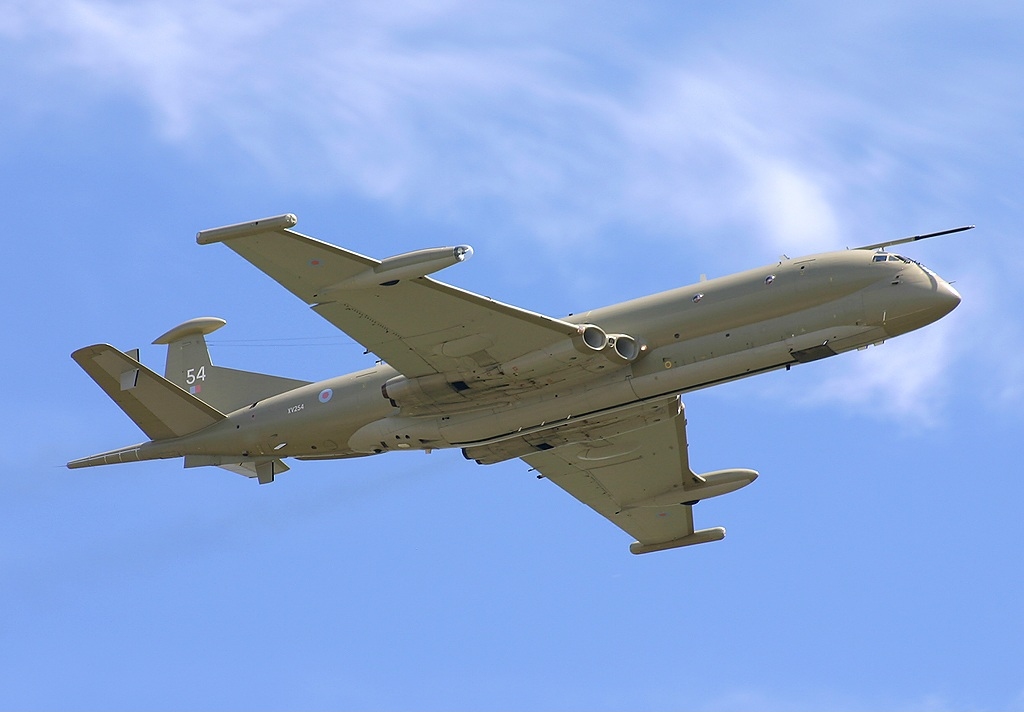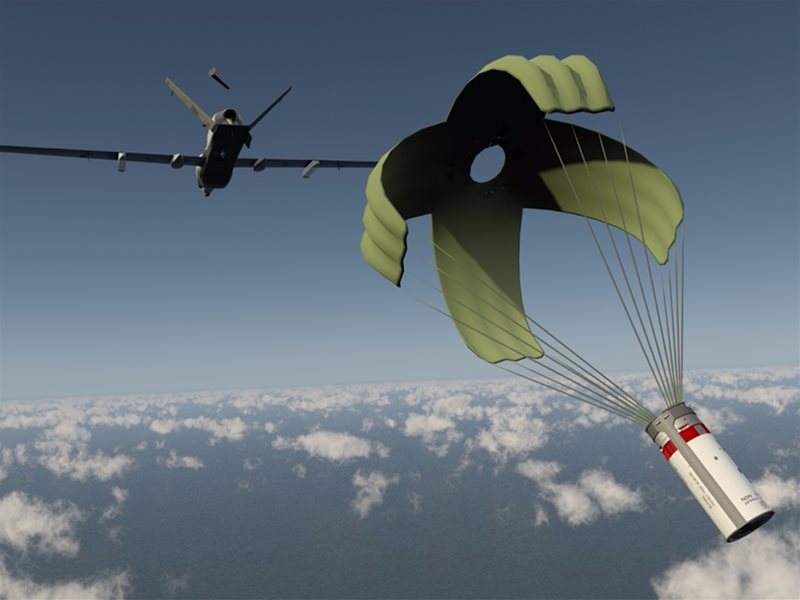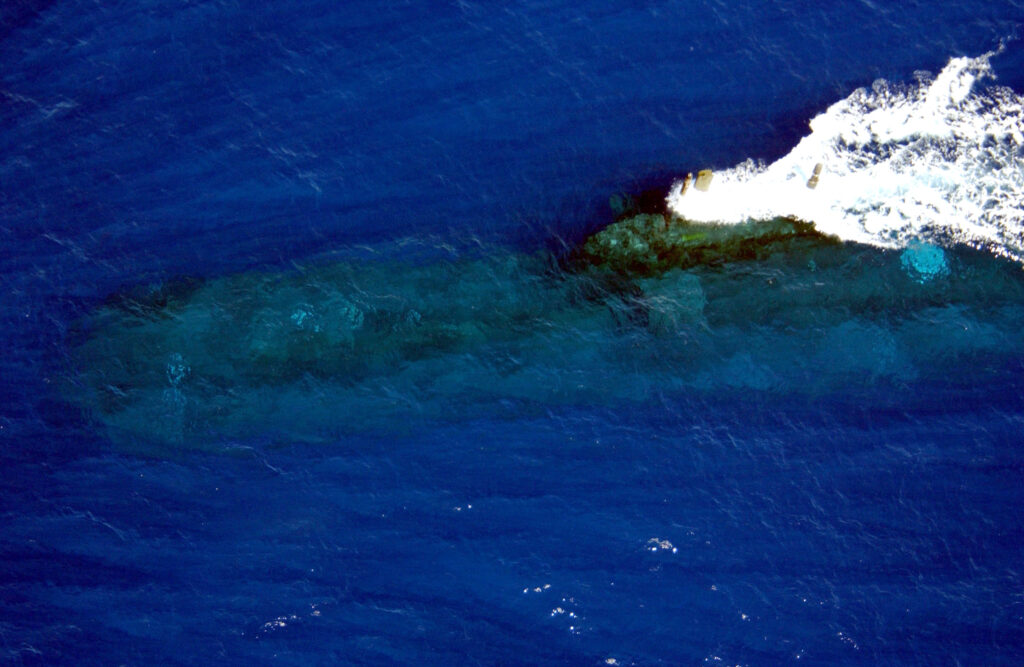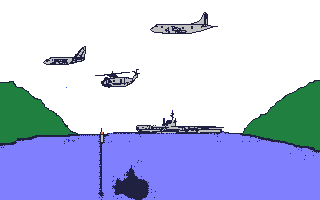Air Anti-Submarine Warfare
Air ASW efforts began in earnest during World War II to counter the dangerous submarine threat. The devastation and terror experienced earlier during World War I dramatically prioritized the requirement for effective ASW forces; including aircraft. The duelists, the aircraft and the submarine, have been locked into an intense chess match ever since World War II. With each new tactical or technological innovation for Air ASW, the submarine threat counters with either a new procedure or system. The three distinct historic phases of Air ASW include the World War II years, the Cold War period, and the Post-Cold War era.
World War II Years
Aircraft in the early days of Air ASW primarily relied upon visual lookouts to detect submarines. These patrolling aircraft consisted mainly of Consolidated PBY-5 Catalina seaplanes, smaller aircraft, and various airships (or blimps). Their weapon systems were limited to guns, depth bombs, and rockets.
Of course, having offensive weapons did not necessarily ensure aircraft survivability. In June 1943, Airship K-74 on a night patrol off the Florida coast attacked a surfaced German submarine. The airship was shot down in the ensuing gun duel. The submarine, U-134, was forced to return to base. As the submarine struggled back home, it survived two subsequent attacks but was finally sunk by British bombers in the Bay of Biscay.
In the European theater, ASW aircraft patrolled from airfields in Iceland and French Morocco as well as various European airstrips. Coverage of the North Atlantic came from Argentia located in Newfoundland, Canada while patrols from Natal, Brazil watched the South Atlantic. Aircraft operated from many sites within the continental U.S. as well as Puerto Rico, Cuba, Trinidad, and Panama to cover the Caribbean and the Gulf of Mexico.
The Japanese submarine threat was countered by aircrews operating from Australia and the many islands of the South Pacific, Hawaii, and the Aleutians. Protection of the West Coast was provided mainly from airfields in San Diego and Moffett Field, California. Interestingly enough, seaplanes operating from distant bases were periodically refueled at sea by submarines designed to deliver aviation gasoline.
World War II-vintage diesel submarines still had to surface during the night to re-charge their spent batteries. ASW aircraft countered these submarine nighttime operations with searchlights, flares and radar systems. This worked for a while until the submarine community responded with electro-magnetic sensors to detect aircraft radar emissions, snorkels to minimize their exposed hull surfaces, and radar decoys. Other ASW aircraft sensors employed during World War II included MAD and sonobuoys. Additionally, aircraft went through many different paint camouflage schemes to mask their appearance not only from hostile submarines, but also from enemy aircraft, ships, and coastal land watch.
Prior to the attack on Pearl Harbor, Catalina aircraft began experimentation with Magnetic Anomaly Detection (MAD) systems. A Catalina operating from Quonset Point, Rhode Island successfully demonstrated the MAD system by detecting a submarine during the initial testing. Additionally, ten days after the Pearl Harbor attack, the Naval Research Laboratory (NRL) satisfactorily demonstrated a duplex switch which allowed a Catalina radar system to transmit and receive electromagnetic pulses without using a cumbersome secondary antenna system.
Although sonobuoys had been developed in 1941, the concept was not fully endorsed. Meanwhile, blimps were wasting time and weapons after detecting multiple MADs of sunken ships and old wrecks. They needed a sensor to validate and corroborate MAD contacts. Hence the passive sonobuoy concept was "dusted off" the shelves for use by the airships. In February 1942, the Navy's Coordinator for Research and Development requested the National Defense Research Committee (NDRC) to develop an expendable radio sonobuoy which could be used by lighter-than-air (LTA) aircraft.
In March 1942, the practicality of sonobuoys was demonstrated off New London, Connecticut as a K-5 blimp detected the propeller sounds of the submarine S-20 at maximum distances of three miles. Radio reception of the signals, however, was limited to five miles. In October 1942, the Bureau of Ships began sonobuoy procurement by purchasing 1,000 sonobuoys and 100 ASW receivers.
Later in June, Project Sail was formally established at Quonset Point for conducting MAD system research and testing. Sponsored by the Naval Ordnance Laboratory and the NDRC, the promising results conducted with airships and an Army B-18 resulted in the procurement of 200 MAD units. The successful deployment of a working MAD system consequently led to the requirement for a weapon system to attack submarines. Detection of MAD signatures occurs after the aircraft has flown over the submarine. Hence, a retro-rocket weapon was designed to fly backwards a short distance to the approximate position where the MAD anomaly was detected and release a depth bomb. These retro-rockets were designed by the California Institute of Technology using a Catalina aircraft. They were installed a year later to complement the MAD gear in VP-63 aircraft. In January 1944, VP-63 aircraft began patrolling the Straits of Gibraltar. The aircraft threat and the associated MAD gear effectively closed submarine daylight transits through this narrow channel. Five weeks later, VP-63 detected the MAD signature of a submarine attempting to cross the straits. Attacked by Catalina retro-rockets, the submarine (U-761) was later sunk with the assistance of two other ships and additional aircraft.
Air ASW efforts were not just limited to improved sensors; improvements in ASW aircrafts were also examined. In June 1942, Igor Sikorsky's VS-300 helicopter was inspected by naval personnel and recommended for ASW and life-saving operations. The following month, the Bureau of Aeronautics issued a Planning Directive calling for the procurement of Sikorsky's helicopters. In April 1943, the Commander-in-Chief of the U.S. Fleet established a joint board to evaluate helicopters for ASW. Later that June, helicopters were recommended to carry radar and dipping sonar systems and to use these primitive helicopters as a hunter platform rather than a killer unit. By January 1944, it was determined that a helicopter with ASW capability would be limited to coastal waters until flight performance improvements could be made.
Meanwhile, in February 1943, a Letter of Intent (LOI) was sent to the Lockheed Vega Airplane Division for the development of two XP2V-1 patrol planes. This would be the initial development of the U.S. Navy's patrol plane workhorse through the early 1960's, the Lockheed P-2V Neptune.
By the end of the war, Navy and Marine aircraft sank 13 submarines. Working with other forces, they sank 26 submarines (6 Japanese, 20 German).
Cold War Period
As the United States entered the Cold War period, Air ASW advancements continued as the Martin SP-5B Marlin seaplane, the Lockheed P-2V Neptune and the Grumann S-2F Tracker aircraft began searching for Soviet submarines. Also, the effectiveness of helicopters with dipping (or dunking) sonars would now be emphasized. Meanwhile, the submarine fleet was getting harder to find. As nuclear submarines began entering the inventory in the mid-1950's and newer diesel submarines were constructed, more advance Air ASW systems would have to be developed. One method of acoustically locating submarines was through the use of "Julie." "Julie" utilized small explosive charges which created an acoustic pulse that was bounced off submarine hulls and detected by passive sonobuoys. Conversely, a passive method to find snorkeling diesel submarines was a system called "sniffer." "Sniffer" operated somewhat similar to today's smoke detectors. It detected minute air particles and contaminants from the operation of a submarine diesel engine. Aircraft would mark their position after each sniffer detection. After several detections and adjusting for the wind, aircrews could begin localizing the snorkeling diesel submarine.
Most of the Air ASW operations were against the quickly growing Soviet submarine fleet. Typical ASW operations included tracking ballistic missile submarines as well as searching for attack and guided missile submarines shadowing the U.S. Fleet. Sonobuoys began to be used quite extensively during this period. Additionally, a lot of research was conducted to determine sound transmission characteristics of the ocean. This would lead to different sonobuoy designs to catalog water temperature profiles, to measure background noise levels, and to distinguish the different natural and manmade sounds.
Initial operating tests of the XCF dunking sonar began in January 1946. The sonar was carried aboard an H02S helicopter flying from Key West, Florida. Meanwhile, production of the Lockheed P-2V Neptune began at the end of World War II. Neptune aircraft production for the U.S. Navy would continue until 1962. During the time period, the Neptune would demonstrating its versatility by setting several endurance records as well as launching from the carrier deck of the U.S.S. Coral Sea using jet-assisted take-off (JATO) bottles.
Anecdotally, the Navy and the Bureau of Standards in late 1953 announced a joint project called "Tinker Toy". They were developing a process for the automated manufacture of electronic equipment and demonstrated its success by assembling a sonobuoy. Through this project, the sonobuoy would become a pivotal ground-breaker for the development of the microelectronic and solid state circuitry manufacturing industry.
In late spring, 1958, the HSS-1N helicopter, capable of both day and night ASW in poor weather conditions was publicly flown. By late summer that same year the Lockheed Electra civilian airliner design, selected as a replacement for the venerable Neptune, would fly its maiden flight as a P3V-1. By mid-March the following year, the HSS-2 amphibian all-weather ASW helicopter would also make its first flight.
The first P-3A was produced on April 15, 1961. It would later be followed by the P-3B which included more powerful engines and improved ASW acoustic sensors. In May 1969, the P-3C Orion aircraft was unveiled. As the P-3 Orion aircraft continued to enter the Fleet, older ASW aircraft began to be phased out. For example, the SP-5B Marlin of VP-40 completed the last U.S. Navy seaplane flight in October 1967. Additionally, the Navy Air Systems Command initiated a contract with Lockheed in August 1969 to develop the S-3 Viking to replace the aging Grumann S-2 Tracker.
The beginning years of the next decade saw many changes in Air ASW platforms. In July 1970, the P-3C Orion began its first operational deployment from Keflavik, Iceland. The advancements of the P-3C included the processing of directional sonobuoys as well as an onboard computer system. On October 1972, the SH-2D LAMPS Mk I helicopter was accepted for Fleet usage.
In November 1971, the first S-3A was completed by Lockheed. In January 1972, the S-3A completed its inaugural flight. The S-3A Viking would double the speed and range of its predecessor as well as tripling the search area capability. It began acceptance trials in October 1973 and was officially introduced into the Fleet in February 1974.
Also in 1974, a Harpoon air-to-surface missile was first launched by a P-3 Orion. This would lead to an expanded role for the versatile land-based aircraft. During the fall, a prototype LAMPS Mk III H-2/SR helicopter was delivered to the Kaman Aerospace Corporation for flight certification. The following year, in 1975, the first production P-3C Update I aircraft was delivered to VX-1. It included upgrades in navigation by the addition of the OMEGA system, better acoustic processors, a tactical display scope, and a seven-fold increase in computer memory. That same year saw the end of an era as the last S-2 Tracker was withdrawn from service after 22 years of operation.
On August 29, 1977, the first P-3C Update II arrived at the Naval Air Test Center for technical evaluation. It included an Infra-Red Detection System (IRDS) and was outfitted for the Harpoon air-to-surface missile. The first launch of a Harpoon missile by an operational squadron occurred in July 1979. Earlier in September 1978, the P-3C Update III test platform was delivered. The P-3C Update III would include an advance signal processor to replace the aging AN/AQA-7 acoustic processors. Additionally, the last P-2V Neptune rolled off the production line heading for Japan.
Meanwhile a new ASW helicopter, the LAMPS Mk III built by Sikorsky, was selected by the Navy on September 1, 1977. The following February, the Department of Defense authorized full scale development of the LAMPS Mk III. The SH-60B Seahawk LAMPS Mk III mock-up was put through shipboard compatibility trial during the summer of 1978. The following year, Sikorsky unveiled the SH-60B. The LAMPS Mk III would greatly expand and augment the ASW and anti-surface warfare (ASUW) role played by the destroyers and cruisers.
In 1982, the terror of the submarine threat was re-emphasized as an old Argentine submarine built during World War II successfully evaded determined and well-equipped British ASW forces during the Falkland Islands War. The Argentine submarine-launched torpedo attacks were unsuccessful due to the antiquity of the 1940's vintage weapons. Conversely, the threat posed by British submarines and aircraft severely restricted the Argentine Navy to the safety of the South American coast. From either perspective, the submarine threat and the ASW capabilities of each fleet were primary factors in the final outcome.
In 1985, the improved version of the Viking, the S-3B, was flown. It would include extensively improved acoustic and non-acoustic sensors as well as outfitting for the Harpoon missile. By the late 1980's, the SH-60F was developed to begin replacing the aging SH-3 helicopter. The SH-60F included an improved dipping sonar system and coupled it to the airframe of the successful SH-60B LAMPS Mk III helicopter. The SH-60F helicopter would provide inner zone protection of carrier battle groups. Additionally, a standardized helicopter airframe for both LAMPS and inner zone protection missions yields significant logistical savings.
Post-Cold War Era
Post-Cold War ASW operations continued....however with a new submarine threat. Many Third World nations began purchasing some of the latest designs in diesel submarine technology. Rapid advances in battery technology and alternate energy producing systems have extended the submerged endurance of a diesel submarine operating on batteries. Additionally, new designs and materials have been used to quiet noisy submarine sources as well as defeat active sonar systems. Also, these newer submarines now operate in the much noiser and difficult shallow waters along the coast (littoral waters). These modernized diesel submarines can be used to insert military personnel, lay deadly minefields, launch devastating cruise and guided missile, threaten vital shipping lanes, and of course, attack ships and submarines.
Passive acoustic detection of these increasingly quiet submarines has been limited and forced Air ASW aircrews to counter with improved active sonar systems as we enter the 21st century. Nevertheless, the Air ASW challenges ahead continue to be met by the US Navy's frontline ASW aircraft; the P-3C Updates II and III, the S-3B, the SH-60B/F and the SH-2G.
ASW Sensors
Detecting the stealthy submarine starts with maintaining a tool kit of different sensors. Each sensor has specific applications that counters different submarine operations. Many of these sensors complement and corroborate each other to enhance ASW effectiveness. Air ASW sensors are divided into two basic types; acoustic and non-acoustic. In some foreign services, these acoustic and non-acoustic sensors are commonly referred to as wet- and dry-end sensors,
Non-acoustic sensors augment the detection capability provided by acoustic sensors. These sensors use radar to detect exposed periscopes and hull surfaces, electro-magnetic systems to intercept the radar emissions from submarines, infra-red receivers to detect the heat signatures of surfaced submarines, or Magnetic Anomaly Detectors (MAD) to sense small changes in the Earth's magnetic field caused by the passage of a submarine. This sophisticated technology is further enhanced by vigilant lookouts who are carefully scanning the turbulent ocean surface for submarine periscopes and wakes.
Radar Sensors
Radar sensors have been used since World War II for the detection of surfaced or snorkeling submarines. Back then, submarines relied upon their batteries for submerged operations. Eventually their batteries would become drained to the point where they were forced to return to the surface and operate their diesel engines to re-charge the battery. While surfaced, the submarine was extremely vulnerable to detection by both radar and visual sensors. The addition of a snorkel enabled the submarine to operate its battery-charging diesel engines while minimizing its exposure to radar and visual sensors. Additionally, the background clutter of the surrounding ocean waves limited radar and visual detection. Also, the development of submarine-based electro-magnetic sensors provided the submarine commander with suffficient warning to dive if approaching radar emissions were detected.
Eventually, nuclear submarines where developed which eliminated the need to periodically recharge the batteries. Despite this significant advance, not all nations were able to build nuclear submarines due to financial and technological reasons. Those nations which remain committed to diesel power have pursued technology which limits the number of times the submarine has to recharge its batteries. However, many submarine commanders must still use their periscopes to provide final visual classification of targets prior to attack. Because of this requirement for target verification, radar systems are still used to detect submarine periscopes.
Today's airborne radar systems must be lightweight yet sufficiently capable for ASW operations, long-range detection and surveillance of surface vessels, airborne navigation, and weather avoidance. For that purpose, many Air ASW radar systems use different radar frequencies, scanning speeds, transmission characteristics, pulse lengths, and signal processing methods that reduce background sea clutter and enhance radar returns from exposed pericopes and submarine hulls. The hostile submarine using electro-magnetic sensors, however, can still detect ASW aircraft radar emissions at a much greater distance than the aircraft can detect the submarine by radar. Nevertheless, the threat of radar detection is sufficient to keep the submarine submerged. Radar systems now used aboard U.S. Navy ASW aircraft include the AN/APS-115 (P-3C), AN/APS-124 (SH-60B), and AN/APS-137 (S-3B, some P-3Cs).
Magnetic Anomaly Detection (MAD) Sensors
MAD sensors are used to detect the natural and manmade differences in the Earth's magnetic fields. Some of these differences are caused by the Earth's geological structures and sunspot activity. Other changes can be caused by the passing of large ferrous objects, such as ships, submarines or even aircraft through the Earth's magnetic field. MAD sensor operation is similar in principle to the metal detector used by a treasure hunter or the devices used by utility companies to find underground pipes.
For ASW purposes, the ASW aircraft must almost be essentially overhead or very near the submarine's position to detect the change or anomaly. The detection range is normally related to the distance between the aircraft sensor ("MAD head") and the submarine. Naturally, the size of the submarine and its hull material composition normally determines the strength of the anomaly. Additionally, the direction travelled by both the aircraft and the submarine relative to the Earth's magnetic field is also a factor. Nevertheless, the close proximity required for magnetic anomaly detection makes the MAD system an excellent sensor for pinpointing a submarine's position prior to an air-launched torpedo attack.
In order to detect an anomaly, the MAD head of the aircraft tries to align itself with the noise produced by the Earth's magnetic field. Through this alignment, the noise appears as a near-constant background noise value which enables the operator to recognize any contrasting submarine magnetic anomalies from the background noise. However, any rapid changes in aircraft direction or the operation of certain electronic equipment and electric motors can produce so much aircraft electro-magnetic noise that makes the detection of the submarine's magnetic signature virtually impossible. Special electronic circuitry is enabled to compensate and null out this aircraft magnetic noise. Additionally, the MAD head is placed the farthest distance away from all the interfering sources. That is why the P-3C Orion aircraft has its distinct tail stinger or "MAD boom". On the S-3B, a similar MAD boom is installed and is electrically extended away from the aircraft during MAD operations. Additionally, the SH-60B extends a towed device called a "MAD bird" to reduce aircraft magnetic noise. With continuing advances in both compensation and sensor technology, the detection ranges for MAD sensors may be enhanced for the search and localization phases of ASW missions. Currently all naval ASW aircraft use variations of the AN/ASQ-81 MAD system. A few P-3C aircraft use an advance MAD system, the AN/ASQ-208, that uses digital processing.
Electro-Magnetic (EM) Sensors
Electro-Magnetic (EM) sensors passively scan the radio frequency spectrum for intentional electronic transmissions from hostile forces. These electronic emissions originate from land sites, ships, and aircraft. They can also be detected from submarines. By comparison, Air ASW EM sensors are sophisticated versions of radar detectors used to sense police radar gun signals. The difference, of course, is that Air ASW EM sensors provide all the details necessary to classify and localize the type of electro-magnetic emission that has been detected.
Since the radio-frequency spectrum is extremely cluttered with both hostile, friendly, and neutral electronic emissions, ASW aircraft EM systems are designed to search mainly for radar signals. To further reduce the electronic clutter, signature libraries are used to selectively search for specific submarine radar signals while disregarding signals from friendly and neutral radar systems. Detection of electronic emissions, however, is dependent upon the submarine commander's gamble to operate the submarine radar. Although, EM systems are not normally one of the primary ASW sensors, its flexibility for detecting hostile aircraft and naval combatants at long ranges makes it an effective sensor for all air warfare missions. Its potential presence deters the operation of submarine radar systems forcing the submarine commander to rely on other less accurate sensors to find targets. EM systems installed on naval ASW aircraft include the AN/ALQ-78 and AN/ALR-66 series on the P-3C Orion, the AN/ALQ-142 on the SH-60B Seahawk, and the AN/ALR-76 on the S-3B Viking.
Infra-Red (IR) Sensors
IRsensors are used to detect the heat signatures that extend beyond the visible light spectrum. They are commonly called either FLIR (Forward Looking Infra-Red) or IRDS (Infra-Red Detection System). The major difference between FLIR and IRDS is that FLIR passively scans for IR sources forward of the aircraft whereas IRDS searches all around the aircraft. This passive sensor device must be cryogenically cooled in order to detect IR sources. The IR signature itself can be masked by warm waters and high humidity. When conditions permit, medium detection ranges can be obtained that are comparable or even better than normal visual search ranges. At night, the system works even better as long as there is a noticeable difference in temperature between the source and the background environment. IR systems for nighttime ASW operations have replaced the previous method of illuminating the ocean with either a searchlight or flares; active visual search methods. By using a passive system such as either FLIR or IRDS, the submarine commander has another dilemma to solve on whether to snorkel or surface during the night. Most ASW aircraft utilize the IR sensors not only for ASW, but also for maritime surveillance.
Visual Sensors
Many submarine contacts are still detected using visual scanning techniques. These techniques are sometimes augmented by sophisticated binocular and other electro-optical devices. Submarine commanders are still wary of being visually spotted and maintain a safe speed when their periscopes are exposed so that their telltale wake remains indistinct compared to the background sea clutter. The position of the Sun and the Moon as well as the direction of the ocean waves are all factors the submarine commander must consider in order to remain unobserved. In some regions of the world, phosphorescent marine organisms illuminate a submerged submarine allowing it to be visually spotted. Additionally, some aircrews may use night vision goggles to aid in visual detection at night.
Link









